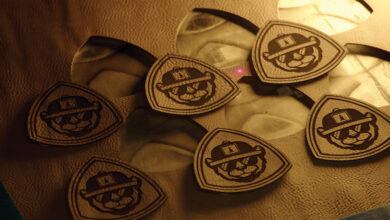Engraving plates may be decorated by the manufacturer, making the engraving area non-rectangular. Often the shape looks like two backward parentheses, adding a nice flair to the look. If the center is wide enough, you can still create a rectangular layout area.
Another way to look at this area is that you have extra space towards the top and bottom to use. The top wider area may allow for highlighting the organization giving the award, the name of the award, or the recipient. This extra space may accommodate a larger or bolder font, wide rectangular logo, or a script or italicized font. If the body text or sentiment would be next in your layout, it should fit nicely in the middle, perhaps left justified. The larger bottom section might include the date or perhaps the organization giving the award or their logo.
Some organizations are sensitive about the placement of their name or logo. Some insist on a top placement, others want it on the bottom. If the name and the logo both appear on the award, splitting them between the top and bottom may be a good layout choice. Knowing the customer’s sensitivities is important.
In addition to non-rectangular engraving plates, many acrylics have similar engraving areas. I have a few clients who like to use paperweights as recognition awards. Some are square, and others are star-shaped. Stars don’t accommodate a large amount of text. State-shaped plaques are sometimes chosen by your customers as well. Proximity is the key design element to focus on. Create rectangular or square sections to keep related information together.
The key to laying out an odd-shaped area is not to fall into the trap of allowing the available area to determine what information to place and where. You might think, “I have a long title, so I’ll place it in this big wide area.” It’s tempting, but make sure related information stays together and reading the award makes sense.
-Bob Hagel, Eagle’s Mark



